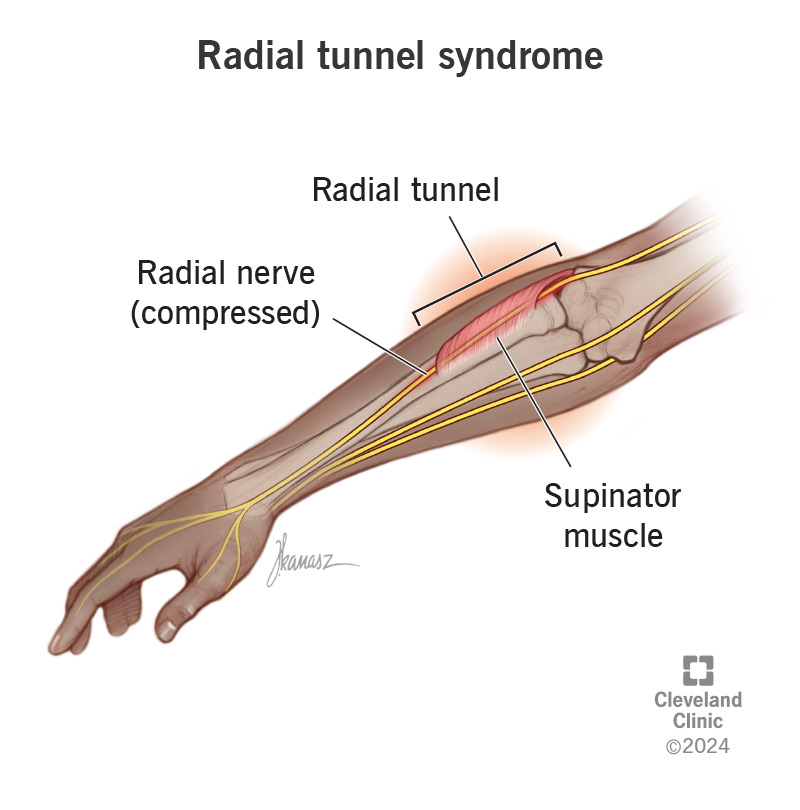Radial tunnel syndrome is a rare, painful condition that occurs when tightness and swelling in the radial tunnel puts too much pressure on your radial nerve. It’s important to rest your arm and seek treatment from a healthcare provider, as the pinched nerve won’t heal on its own. Treatment is usually nonsurgical.
Advertisement
Cleveland Clinic is a non-profit academic medical center. Advertising on our site helps support our mission. We do not endorse non-Cleveland Clinic products or services. Policy

Radial tunnel syndrome is a condition that occurs when your radial nerve — one of the nerves that run through your arm — is pinched or compressed. When your radial nerve reaches your elbow and forearm, it passes through an area called the radial tunnel, which is a collection of muscles and tendons. Tightness and swelling in the radial tunnel can put pressure on your radial nerve, leading to a nagging pain and weakness in your arm.
Advertisement
Cleveland Clinic is a non-profit academic medical center. Advertising on our site helps support our mission. We do not endorse non-Cleveland Clinic products or services. Policy
Radial tunnel syndrome creates an annoying ache in your arm that you just want to shake away. Fortunately, rest and nonsurgical methods are usually successful at treating the pinched nerve and relieving your pain.
If you have pain in your elbow and forearm, see your healthcare provider for treatment recommendations.
You’ll likely feel pain and tenderness in the area on the outside of your elbow, stretching down to your forearm. The pain is a nagging ache that can stick with you and cause fatigue. Certain activities can make radial tunnel syndrome symptoms worse, including:
Over time, radial tunnel syndrome can weaken your forearm muscles and your overall wrist strength, making it increasingly difficult to grip or lift certain things. The pain may also get worse while you’re sleeping. Sometimes, radial tunnel syndrome can cause wrist drop, meaning you lose the ability to lift your hand past a certain point.
Tennis elbow is a condition that has a lot of similar symptoms, so it’s important to be specific when talking with your healthcare provider about your symptoms.
Advertisement
When your radial nerve goes through the radial tunnel below your elbow, it travels between different muscle bellies and under fascial bands. (Fascial bands are tissue fibers that enclose, separate or bind together muscles, organs and other soft structures in your body.) When inflammation affects the radial tunnel and all the structures inside, it puts too much pressure on your radial nerve, leading to the condition. There are many activities that can lead to the inflammation that causes radial tunnel syndrome, including:
Radial tunnel syndrome is most common in people between the ages of 30 and 50. Women are also much more likely to develop this condition than men. There are also certain factors that may put you at a greater risk of developing radial tunnel syndrome, including:
A healthcare provider will ask you about your specific pain, your medical history and your symptoms. Then, they’ll perform a physical exam, focusing on your elbow and forearm. They’ll try to find the exact point where your radial nerve is being compressed inside the radial tunnel by feeling around the outside of your elbow and applying light pressure.
There are two specific tests that your healthcare provider may use to diagnose this condition:
There are no formal tests that can diagnose radial tunnel syndrome, which makes diagnosing the condition difficult. Your provider may order certain tests to rule out other potential injuries or conditions. These imaging tests may include:
Advertisement
The best way to treat this condition is to stop, or drastically reduce, the activity that causes your symptoms. If you can, try to rest your arm and avoid any movements that cause pain. Rest and medical treatment are generally successful in relieving symptoms in six weeks for most people.
There are additional treatment options to relieve the pain associated with radial tunnel syndrome, including:
The goal of treatment is to eliminate your symptoms and prevent them from coming back. If your job is causing your symptoms, you may need to change your work site or talk about getting more breaks during the workday. Try to avoid any heavy push-and-pull movements, if possible.
For athletes, practice strength and flexibility exercises and always remember to adequately warm up before playing or practicing.
Advertisement
There is a surgical treatment for this condition, but your provider will likely only recommend it if rest and nonoperative therapy doesn’t work. The goal of radial tunnel release is to take the unwanted pressure off your radial nerve as it passes through the radial tunnel.
Questions you may want to ask your provider about radial tunnel syndrome include:
It’s unlikely that your symptoms will improve without treatment, and your symptoms can worsen over time. Untreated, the condition can result in chronic pain in your forearm.
Nonsurgical medical treatment is typically successful for the condition, if you carefully follow instructions and avoid any future injuries to your radial nerve. If you don’t have success with nonsurgical treatment, surgery is an option that can be effective in improving symptoms. Some people do continue to experience mild pain, even after surgery.
The pain associated with radial tunnel can make performing everyday tasks difficult. It can affect your daily activities, work, sports and leisure activities. It’s important to rest your arm and stop doing the things that are causing your symptoms. See a healthcare provider for treatment and you’ll be on your way to being pain-free.
Advertisement
From sudden injuries to chronic conditions, Cleveland Clinic’s orthopaedic providers can guide you through testing, treatment and beyond.

Last reviewed on 01/06/2025.
Learn more about the Health Library and our editorial process.